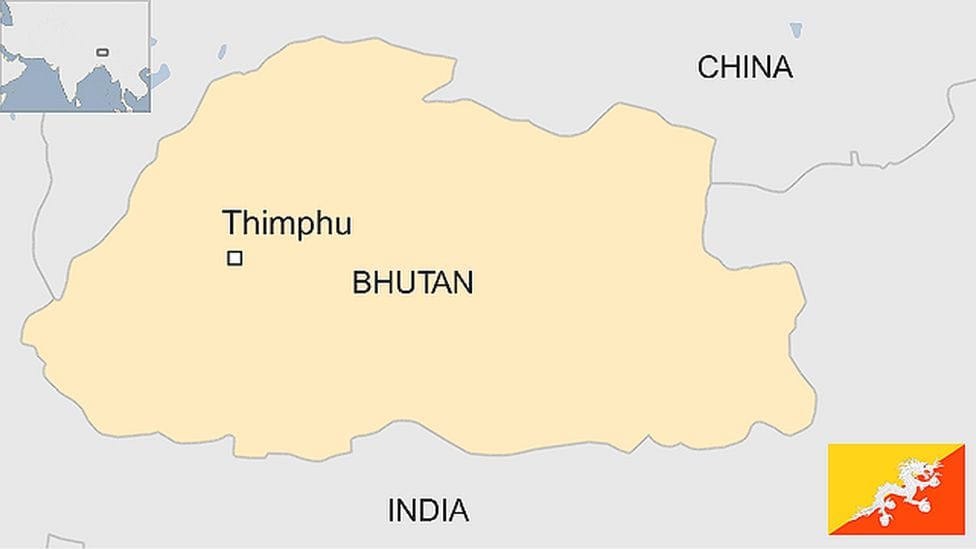Nestled amidst the towering peaks of the Himalayas lies Thimphu, the captivating capital of Bhutan. This extraordinary city seamlessly blends ancient traditions with modern amenities, offering a glimpse into a world where spirituality and progress coexist. Journey with us as we uncover the hidden gems of Thimphu, from its sacred monasteries and vibrant markets to its breathtaking natural beauty and unique cultural heritage.
Capital of Bhutan: Thimphu, Where Ancient Vibes Meet Modern Life
High in the Himalayas, at over 2,000 meters above sea level, sits Thimphu, Bhutan’s largest city and beating heart. This intriguing capital city effortlessly combines the tranquility of its ancient roots with the dynamism of modern advancements. Unlike many capital cities across the globe, Thimphu doesn’t have an airport. This unusual characteristic has helped preserve the city’s peaceful ambiance and protect its unique cultural identity.
Thimphu is home to significant landmarks such as the impressive National Assembly and the majestic Dechencholing Palace, showcasing its role as the political and economic center of Bhutan. The city’s strategic location in the Thimphu Valley provides a temperate climate and breathtaking vistas of the surrounding mountains.
Wandering through Thimphu’s streets is like taking a step back in time. Colorful festivals erupt with vibrant energy, bustling markets beckon with local crafts and delicacies, and ancient monasteries stand as serene guardians of Bhutan’s spiritual heritage. This harmonious blend of old and new makes Thimphu a captivating destination.
Thimphu’s commitment to sustainable tourism is evident in its approach to managing visitor numbers, ensuring the preservation of its natural beauty and cultural heritage. This mindful approach makes it a shining example for other cities striving to balance growth with preservation.
- The capital city of Canada is Ottawa. Check This Out for more information on Canadian cities.
- Do you know the capital city of Australia? Click Here to find out.
- What’s the capital city of Madagascar? Check My Blog for the answer.
- Astana is the capital of Kazakhstan. Click Here to learn more about this fascinating city.
- Tirana is the capital of Albania. Click Here to learn more about this beautiful country.
- The capital of Cambodia is Phnom Penh. Click Here to learn more about this historic city.
- Oslo is the capital of Norway. Click Here to learn more about this Scandinavian gem.
- Taipei is the capital of Taiwan. Click Here to learn more about this vibrant city.
What is the New Capital of Bhutan?
While Thimphu flourishes as the modern capital of Bhutan, it’s essential to acknowledge that it hasn’t always held this title. Before 1955, the historic city of Punakha served as the nation’s capital. The shift to Thimphu came with the vision of the Third King of Bhutan, Jigme Dorji Wangchuck, who sought a more centrally located and modern capital.
Thimphu, situated in the heart of west-central Bhutan, offered a strategic advantage. At an elevation of 2,320 meters (7,656 feet), it enjoys a pleasant climate, neither too hot nor too cold. The Thimphu Valley, cradled by the protective embrace of the Himalayas, added to its allure.
This move wasn’t just about geography; it was about progress and accessibility. Thimphu’s central location made it easier to connect with other parts of the country. Over time, it blossomed into the vibrant and dynamic capital it is today, serving as a hub for:
- Politics: Government offices, the National Assembly, and ministries operate from Thimphu.
- Diplomacy: Embassies and consulates from around the world have established a presence in the city.
- Economy: Tourism flourishes in Thimphu, contributing significantly to Bhutan’s economic growth, alongside trade and finance.
Thimphu embodies the spirit of Bhutan, where age-old traditions and modern progress intertwine seamlessly. The city’s unique balance continues to captivate visitors, offering a glimpse into a nation forging a path into the future while honoring its rich past.
Why is Bhutan So Famous?
The Kingdom of Bhutan, nestled high in the Himalayas, has captured the world’s attention, and for good reason. This small nation offers a unique perspective on life, prioritizing happiness, cultural preservation, and environmental sustainability.
Gross National Happiness:
Bhutan’s commitment to measuring its progress through Gross National Happiness (GNH) sets it apart. This philosophy emphasizes the well-being of its citizens over material wealth. GNH balances economic growth with environmental conservation, cultural preservation, and good governance, creating a society that values happiness and contentment.
Nature’s Masterpiece:
Bhutan’s natural beauty is undeniable. Lush valleys, towering Himalayan peaks, pristine rivers, and diverse ecosystems create a paradise for nature enthusiasts. The opportunity to spot rare and endangered species, such as the elusive snow leopard, adds to the allure for adventurers and wildlife lovers.
Cultural Treasure Trove:
Bhutan’s culture is as vibrant as the prayer flags that flutter in the wind. Ancient monasteries cling to cliffsides, while colorful festivals fill the streets with music, dance, and traditional rituals. The preservation of ancient crafts and customs provides visitors with an authentic cultural experience.
Sustainable Tourism:
Bhutan is a global leader in sustainable tourism. As a carbon-negative country, it absorbs more carbon dioxide than it emits. The daily Sustainable Development Fee implemented for tourists supports conservation efforts and promotes responsible travel, ensuring that tourism benefits both visitors and local communities.
Bhutan’s allure extends beyond these highlights. The warmth and hospitality of the Bhutanese people, along with the country’s delectable cuisine, contribute to its reputation as a must-visit destination. It’s a place that inspires reflection and allows travelers to reconnect with nature, culture, and themselves.
What is the Old Capital of Bhutan?
Before Thimphu became the embodiment of modern Bhutan, the historical city of Punakha held the esteemed title of capital. Strategically located at the confluence of the Pho Chhu (father) and Mo Chhu (mother) rivers in the 17th century, Punakha served as a stronghold for the newly unified Bhutanese kingdom. The majestic Punakha Dzong, a fortress-monastery, stands as a testament to Punakha’s glorious past, showcasing the exceptional craftsmanship of the Bhutanese people.
However, as Bhutan progressed, the need for a more centrally located and accessible capital arose. In 1955, the decision was made to move the capital to Thimphu. Punakha, however, has not faded into obscurity. It remains a significant historical and cultural site, drawing visitors eager to experience Bhutanese traditions firsthand, especially during the vibrant Punakha festival.
Thimphu, with its own dzong, the Tashichho Dzong, beautifully embodies the balance between tradition and progress that characterizes modern Bhutan. The country’s careful preservation of its past, while embracing a future of growth and development, is evident in the way it honors both its former and current capitals.
What is Bhutan’s Capital and Currency?
Bhutan, often referred to as the “Land of the Thunder Dragon,” boasts a unique blend of tradition and modernity. Its capital, Thimphu, exemplifies this delicate balance, showcasing the country’s commitment to preserving its cultural heritage while embracing progress.
Thimphu – The Heart of Bhutan:
Nestled amidst the majestic Himalayas, Thimphu is a city that captivates the senses. While it doesn’t have the towering skyscrapers of other global capitals, its charm lies in its unique blend of ancient and modern. The city’s skyline features a harmonious mix of sleek, modern buildings and ornately decorated temples and dzongs.
The city’s location in the fertile valley provides a temperate climate and breathtaking views. Visitors can explore bustling markets overflowing with local crafts, textiles, and produce, all while being surrounded by stunning natural beauty. Thimphu offers an immersive experience, allowing travelers to witness firsthand Bhutan’s dedication to its cultural identity.
The Ngultrum: Bhutan’s Currency:
The Bhutanese ngultrum (BTN) is the official currency of Bhutan. It is pegged to the Indian rupee (INR) at par, meaning they hold equal value. Indian rupees are also widely accepted throughout Bhutan, making it convenient for travelers from India.
The ngultrum’s banknotes are known for their distinctive designs. They often feature vibrant colors and intricate depictions of significant figures and symbols from Bhutanese culture and history. From mythical creatures to important Buddhist figures, each note tells a story, making them unique souvenirs.
A Quick Recap:
- Capital: Thimphu
- Currency: Bhutanese Ngultrum (BTN)
When planning your trip to Bhutan, remember that exchange rates can fluctuate, so it’s always best to check for the most up-to-date information.
What Language is Spoken in Bhutan?
Bhutan, a landlocked nation nestled in the Himalayas, boasts a linguistic tapestry as diverse as its landscapes. While Dzongkha holds the official language title, over 20 languages are spoken throughout the country, reflecting a rich cultural heritage influenced by its geographical location and interactions with neighboring regions.
Dzongkha – The Official Language:
Dzongkha, meaning “the language of the dzongs,” is Bhutan’s national and official language. It is primarily spoken in Western Bhutan and serves as the language of government, education, and media. Dzongkha belongs to the Tibeto-Burman language family, making it closely related to Tibetan.
A Linguistic Kaleidoscope:
Beyond Dzongkha, Bhutan’s linguistic landscape includes a fascinating array of languages. Most of these languages belong to the Tibeto-Burman family, reflecting the country’s geographical proximity to Tibet and the surrounding Himalayan regions. Nepali, an Indo-Aryan language, stands out as an exception, highlighting the influence of migration and cultural exchange.
The Significance of Tibeto-Burman Languages:
The dominance of Tibeto-Burman languages in Bhutan underscores its historical and cultural ties to Tibet. Dzongkha, along with other Tibetic languages spoken in the country, falls under the Central Bodish group, suggesting a shared linguistic ancestry. East Bodish languages, such as Bumthang and Kheng, also contribute to this diverse tapestry, highlighting the complex linguistic history of the region.
Preserving Linguistic Heritage:
Bhutan’s government recognizes the importance of preserving its linguistic diversity. While promoting Dzongkha as the national language, efforts are underway to protect and revitalize less-spoken languages. This approach ensures that future generations can continue to appreciate and celebrate the full spectrum of Bhutan’s linguistic heritage.
Which Religion is in Bhutan?
Bhutan, nestled amidst the Himalayas, is a country where spirituality is deeply intertwined with daily life. While Buddhism stands as the official religion, the nation embraces religious diversity, fostering a climate of tolerance and respect for different faiths.
Buddhism: The Guiding Light:
Buddhism, particularly Vajrayana Buddhism, is the dominant religion in Bhutan, practiced by approximately 75% of the population. The country’s constitution underscores the importance of Buddhism, mandating that the king be a Buddhist. He is also recognized as the “protector of all religions,” reflecting Bhutan’s commitment to religious freedom.
Hinduism: A Significant Presence:
Hinduism, primarily practiced by the Lhotshampa ethnic group, is the second-largest religion in Bhutan, followed by about 23% of the population. In recognition of its significance, Hinduism was officially recognized as a national religion in 2015.
Bon: Echoes of Ancient Beliefs:
Before the arrival of Buddhism, the people of Bhutan followed Bon, an indigenous belief system rooted in animism and shamanism. While Buddhism has become the dominant religion, traces of Bon traditions persist, often blending with Buddhist practices and rituals.
Respect for Religious Freedom:
Bhutan’s constitution guarantees the freedom to practice any religion. While Buddhism and Hinduism are the most prominent faiths, smaller communities of Christians and Muslims also contribute to the country’s religious diversity.
Harmony and Tolerance:
Bhutan’s approach to religion is characterized by tolerance and respect. Different faiths coexist peacefully, and religious festivals are often celebrated by people of all backgrounds. This harmony adds to the country’s unique cultural tapestry.
What is the Old Name of Bhutan?
Before the world came to know it as Bhutan, this Himalayan kingdom journeyed through history with a different name: Lho Mon. This name, shrouded in the mists of time, translates to “Southern Land of Darkness.”
Lho Mon: A Glimpse into the Past:
The name “Lho Mon” provides insights into Bhutan’s pre-Buddhist past, a time before the 9th century when Buddhism became a dominant force in the region. While the exact meaning of “darkness” in this context is debated, it likely refers to the absence of Buddhist teachings in the region during that era.
The Emergence of “Bhutan”:
The name “Bhutan” likely emerged around the 9th century with the arrival of Buddhism. There are two main theories regarding its origin:
- Bhota-ant: This Sanskrit term translates to “end of Tibet,” reflecting Bhutan’s geographical position at the southern edge of the Tibetan Plateau.
- Bhu-uttan: Another possibility is that “Bhutan” derives from the Sanskrit word “Bhu-uttan,” meaning “high lands,” a fitting description for a country dominated by the towering Himalayas.
Druk Yul: The Land of the Thunder Dragon:
Bhutan is also known as “Druk Yul,” meaning “Land of the Thunder Dragon.” This evocative name is deeply intertwined with Bhutanese culture and identity. The thunder dragon, a mythical creature, symbolizes power, protection, and enlightenment.
Sovereignty and Cultural Preservation:
Bhutan’s fierce independence throughout history has played a vital role in shaping its identity. Unlike many of its neighbors, Bhutan was never colonized, allowing it to preserve its unique culture, traditions, and language. This commitment to sovereignty is reflected in its names, each representing a different facet of its historical and cultural journey.
Unraveling the Past:
Research into Bhutan’s early history is ongoing, and new discoveries could shed further light on the origins of its names. The scarcity of written records from earlier centuries adds to the mystery, making the task of piecing together Bhutan’s past a fascinating endeavor.
How Do You Pronounce the Word Thimphu?
The proper pronunciation of a place’s name is a sign of respect and reflects a deeper understanding of its culture. Thimphu, Bhutan’s capital, is often mispronounced, leading to confusion and miscommunication. So, how do you say it correctly?
In English, the most widely accepted pronunciation of Thimphu is “tim-poo,” with the emphasis placed on the first syllable. It’s helpful to think of it as “timber” without the “ber” sound. Once you get the hang of it, it’s a fairly straightforward pronunciation.
However, for those who want to try pronouncing Thimphu like a local, the Dzongkha pronunciation is closer to “tʰim˥.pʰu˥.” This pronunciation involves subtle nuances in intonation and aspiration, which can be challenging for non-native speakers to master.
The good news is that the pronunciation of Thimphu remains consistent regardless of its grammatical function in a sentence. Whether you’re talking about going to Thimphu, living in Thimphu, or experiencing the beauty of Thimphu, the pronunciation remains the same: “tim-poo.”
Remember, mastering the pronunciation of foreign words takes practice. Don’t be afraid to ask a local or consult online resources for guidance. Embracing the nuances of pronunciation enriches communication and shows respect for the culture you’re engaging with.
Why Doesn’t Bhutan Recognize Many Countries?
Bhutan’s approach to foreign relations might appear unusual to some, but it’s a deliberate strategy rooted in a deep desire to protect its cultural heritage, maintain sovereignty, and navigate a complex geopolitical landscape.
Preserving Cultural Identity:
Bhutan’s isolationist policy stems from a long-held belief that limiting exposure to external influences is crucial to preserving its unique cultural identity. Having witnessed the impact of globalization on other cultures, Bhutan remains cautious about opening its doors too widely, fearing the potential erosion of its traditions and values.
Safeguarding Sovereignty:
Bhutan’s history is marked by a strong sense of independence. Having never been colonized, the country is fiercely protective of its sovereignty. Limiting diplomatic ties can be seen as a way to safeguard its autonomy and ensure that decisions about its future are made internally.
The Influence of India:
India has played a significant role in shaping Bhutan’s foreign policy. The 1910 Treaty of Punakha, while guaranteeing Bhutan’s internal sovereignty, placed its foreign relations under British India’s guidance, a role inherited by India post-independence. While this treaty has been revised over time, India’s influence on Bhutan’s foreign policy remains significant.
A Gradual Opening:
Despite its isolationist tendencies, Bhutan has gradually expanded its diplomatic relations in recent decades. This cautious approach suggests a willingness to engage with the wider world while carefully managing the terms of that engagement.
Unique Considerations:
Several factors likely contribute to Bhutan’s limited diplomatic recognition:
- Economic Resources: Establishing and maintaining diplomatic missions can be costly. Bhutan’s limited resources might necessitate a more selective approach.
- Geopolitical Realities: Bhutan’s location between the two Asian powers, India and China, adds complexity to its foreign policy decisions.
- Tourism Management: Bhutan’s strict tourism policies, aimed at minimizing cultural and environmental impact, align with its broader isolationist stance.
Bhutan’s approach to foreign relations is a complex and evolving tapestry. While the country prioritizes its cultural preservation and sovereignty, it also recognizes the importance of engaging with the global community. It remains to be seen how Bhutan will navigate these competing priorities in the future.
What is Thimphu the Only Capital Without?
In a world dominated by technology and urban sprawl, Bhutan’s capital, Thimphu, stands out for a remarkable distinction: it’s the only capital city in the world without traffic lights. This unusual characteristic reveals a city deeply committed to its traditions, its people, and its environment.
Instead of relying on automated traffic signals, Thimphu employs a more human-centric approach. Traffic police officers, stationed at key intersections, gracefully direct the flow of vehicles using a series of hand gestures. This system, while seemingly simple, is surprisingly effective and adds a unique charm to the city’s ambiance.
The absence of traffic lights is not merely a quirky quirk; it aligns with Bhutan’s broader national philosophy of Gross National Happiness. By prioritizing people over vehicles, Thimphu promotes a slower, more mindful pace of life. It encourages walking and cycling, creating a healthier and more sustainable urban environment.
This unique approach to traffic management has garnered international attention. City planners and urban designers from around the world now look to Thimphu as a model for creating pedestrian-friendly and environmentally conscious cities.
Thimphu’s decision to forgo traffic lights is a testament to the power of simple solutions and a reminder that progress does not always require sacrificing tradition or the well-being of its citizens. It’s an inspiring example of a city that has chosen a different path, one that prioritizes harmony, sustainability, and the happiness of its people.
- How the Telephone Revolutionized Business: A Historical Perspective - April 19, 2025
- Understand bone yellow: Colorism’s impact on Black communities - April 19, 2025
- Green Natural Sandstone: Eco-Friendly Building Solutions - April 19, 2025
















